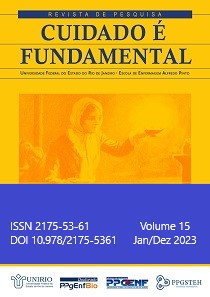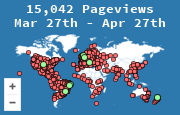Sociodemographic factors and type of delivery:
systematic review
DOI:
https://doi.org/10.9789/2175-5361.rpcfo.v15.11779Keywords:
Delivery, Obstetric, Cesarean Section , Social Determinants of Health , Natural Childbirth , Socioeconomic FactorsAbstract
Objective: to identify the sociodemographic factors associated with the mode of delivery. Methods: this is a systematic review with a search in the Latin American and Caribbean Literature on Health Sciences, PubMed and Cochrane databases in May 2021. The study protocol was registered with PROSPERO under number CRD42021257340. The selected articles were analyzed by the Joanna Briggs Institute and the Grading System of Recommendations Assessment, Development and Evaluation systems. Results: women with a higher socioeconomic level, higher education, aged over 35 years and private institutions have a greater chance of having a cesarean section compared to the vaginal level. The quality of quality of quality for the service provider variable was low and the quality of maternal schooling is low and the quality of economic class is high. Sociodemographic conclusions in the literature.
Downloads
References
Rydahl E, Declercq E, Juhl M, Maimburg RD. Cesarean section on a rise—Does advanced maternal age explain the increase? A population register-based study. PLoS ONE. [Internet]. 2019 [cited 2021 jun 12];14(1). Available from: https://journals.plos.org/plosone/article?id=10.1371/journal.pone.0210655.
Cegolon L, Mastrangelo G, Maso G, et al. Understanding Factors Leading to Primary Cesarean Section and Vaginal Birth After Cesarean Delivery in the Friuli-Venezia Giulia Region (North-Eastern Italy 2005–2015). Sci Rep. [Internet]. 2020 [cited 2021 jun 12];10(1):380. Available from: https://pubmed.ncbi.nlm.nih.gov/31941963/.
World Health Organization (WHO). Global Strategy for Women’s, Children’s and Adolescents’ Health (2016–2030): report by the Director-General - Assembly 72. [Internet]. 2019. [cited 2021 Sep 11]; Available from: https://apps.who.int/iris/handle/10665/328739
Rasador S, Abegg C. Factors associated with the route of birth delivery in a city in the Northeast region in the State of Rio Grande do Sul, Brazil. Rev Bras Saúde Materno Infant. [Internet]. 2019 [cited 2021 jun 13];19(4). Available from: https://www.scielo.br/j/rbsmi/a/JNd5KqYbZRtPW6y6T3C8nhs/?lang=en
Boerma T, Ronsmans C, Melesse DY, Barros AJD, Barros FC, Juan L, et al. Global epidemiology of use of and disparities in caesarean sections. The Lancet. 2018 [cited 2021 jun 15];392(10155). Available from: https://pubmed.ncbi.nlm.nih.gov/30322584/.
National Institute for Health Research (NIHR). PROSPERO International prospective register of systematic reviews. [Internet]. 2020 [cited 2021 apr 29]:1–12. Available from: https://www.crd.york.ac.uk/prospero/
Page MJ, McKenzie JE, Bossuyt PM, Hoffmann T, Mulrow CD, Tetzlaff JM, et al. The PRISMA 2020 statement: an updated guideline for reporting systematic reviews. BMJ. [Internet]. 2021 [cited 2021 ago 27];372:n71. Available from: https://www.bmj.com/content/372/bmj.n71.
Munn Z, Stern C, Aromataris E, Lockwood C, Jordan Z. What kind of systematic review should I conduct? A proposed typology and guidance for systematic reviewers in the medical and health sciences. BMC Med Res Methodol. [Internet]. 2018 [cited 2021 jul 20];18:5. Available from: https://bmcmedresmethodol.biomedcentral.com/articles/10.1186/s12874-017-0468-4
Munn Z, Moola S, Riitano D, Lisy K. The development of a critical appraisal tool for use in systematic reviews addressing questions of prevalence. Int. J. Health Policy Manag. [Internet]. 2014 [cited 2021 jul 20];3(3):123–128. Available from: https://bmcmedresmethodol.biomedcentral.com/articles/10.1186/s12874-017-0468-4
Guyatt GH, Oxman AD, Vist GE, Kunz R, Falck-Ytter Y, et al. GRADE: an emerging consensus on rating quality of evidence and strength of recommendations. BMJ. [Internet]. 2008 [cited 2021 jun 13];336(7650). Available from: https://pubmed.ncbi.nlm.nih.gov/18436948/
Alonso BD, Silva FMB da, Latorre M do RD de O, Diniz CSG, Bick D. Caesarean birth rates in public and privately funded hospitals: a cross-sectional study. Rev. Saúde Pública. [Internet]. 2017 [cited 2021 jun 14];51. Available from: https://www.revistas.usp.br/rsp/article/view/140990
Antunes MB, Rossi RM, Pelloso SM. Relationship between gestational risk and type of delivery in high risk pregnancy. Rev Esc. Enferm. USP [Internet]. 2020 [cited 2021 jun 15];54 Available from: https://www.scielo.br/j/reeusp/a/kqvyvpxg7XkznD4HgnTmLft/?lang=en.
Zaiden L, Nakamura-Pereira M, Gomes MAM, Esteves-Pereira AP, Leal M do C. Influence of hospital characteristics on the performance of elective cesareans in Southeast Brazil. Cad. Saúde Pública. [Internet]. 2019 [cited 2021 jun 16];36. Available from: http://cadernos.ensp.fiocruz.br/static/arquivo/1678-4464-csp-36-01-e00218218-en.pdf.
Martinelli KG, Gama SGN da, Almeida AH do V de, Nakamura-Pereira M, Santos Neto ET dos. Prelabor cesarean section: the role of advanced maternal age and associated factors. Rev Saúde Pública. [Internet]. 2021 [cited 2021 jun 15];55. Available from: https://www.scielo.br/j/rsp/a/46hV8qQ9XxsqWD5wxWdgZrF/.
Rossetto M, Schmalfuss JM, Bedin K, Pinheiro AM, Batista J d’Arc L. Fatores associados à cesariana eletiva em mulheres atendidas em um hospital referência do oeste catarinense. Rev Enferm. UFSM. [Internet]. 2020 [acesso em 20 de junho 2021];10(0):54. Available from: https://periodicos.ufsm.br/reufsm/article/view/39398/html.
Abbas F, Ud Din RA, Sadiq M. Prevalence and determinants of Caesarean delivery in Punjab, Pakistan. East Mediterr Health J. [Internet]. 2019 [cited 2021 jun 21];24(11):1058–1065. Available from: https://pubmed.ncbi.nlm.nih.gov/30701520/.
Begum T, Rahman A, Nababan H, et al. Indications and determinants of caesarean section delivery: Evidence from a population-based study in Matlab, Bangladesh. PLoS ONE. [Internet]. 2017 [cited 2021 jun 17];12(11). Available from: https://pubmed.ncbi.nlm.nih.gov/29155840/
Loenzien M de, Schantz C, Luu BN, Dumont A. Magnitude and correlates of caesarean section in urban and rural areas: A multivariate study in Vietnam. PloS One. 2019 [cited 2021 jun 17];14(7). Available from: https://pubmed.ncbi.nlm.nih.gov/31348791/.
Hasan F, Alam MdM, Hossain MdG. Associated factors and their individual contributions to caesarean delivery among married women in Bangladesh: analysis of Bangladesh demographic and health survey data. BMC Pregnancy Childbirth. [Internet] 2019 [cited 2021 jun 12];19(1). Available from: https://bmcpregnancychildbirth.biomedcentral.com/track/pdf/10.1186/s12884-019-2588-9.pdf
Omani-Samani R, Mohammadi M, Almasi-Hashiani A, Maroufizadeh S. Cesarean Section and Socioeconomic Status in Tehran, Iran. J Res. Health Sci. [Internet] 2017 [cited 2021 jun 10];17(4):394. Available from: https://www.ncbi.nlm.nih.gov/pmc/articles/PMC7189948/.
Adewuyi EO, Auta A, Khanal V, Tapshak SJ, Zhao Y. Cesarean delivery in Nigeria: prevalence and associated factors―a population-based cross-sectional study. BMJ Open. 2019 [cited 2021 jun 10];9(6). Available from: https://bmjopen.bmj.com/content/9/6/e027273.
Dankwah E, Kirychuk S, Zeng W, Feng C, Farag M. Socioeconomic inequalities in the use of caesarean section delivery in Ghana: a cross-sectional study using nationally representative data. Int J Equity Health. [Internet] 2019 [cited 2021 jun 10];18(1). Available from: https://pubmed.ncbi.nlm.nih.gov/31653255/.
Manyeh AK, Amu A, Akpakli DE, Williams J, Gyapong M. Socioeconomic and demographic factors associated with caesarean section delivery in Southern Ghana: evidence from INDEPTH Network member site. BMC Pregnancy Childbirth. [Internet] 2018 [cited 2021 jun 10];18(1). Available from: https://bmcpregnancychildbirth.biomedcentral.com/articles/10.1186/s12884-018-2039-z
Khan MdN, Islam MM, Shariff AA, Alam MdM, Rahman MdM. Socio-demographic predictors and average annual rates of caesarean section in Bangladesh between 2004 and 2014. PLoS ONE. [Internet] 2017 [cited 2021 jun 12];12(5). Available from: https://journals.plos.org/plosone/article?id=10.1371/journal.pone.0177579
Betrán AP, Ye J, Moller A-B, Zhang J, Gülmezoglu AM, Torloni MR. The Increasing Trend in Caesarean Section Rates: Global, Regional and National Estimates: 1990-2014. PLoS ONE. [Internet] 2016 [cited 2021 jun 12];11(2). Available from: https://journals.plos.org/plosone/article?id=10.1371/journal.pone.0148343
Cintia de Freitas Oliveira, Bortoli, M.C, Setti, C., Luquine Júnior, C.D., Toma, T.S. Apoio contínuo na assistência ao parto para redução das cirurgias cesarianas: síntese de evidências para políticas. Cien. Saude Colet. [Internet]. 2021. [cited 2021 jun 14]. Available from: https://www.cienciaesaudecoletiva.com.br/artigos/apoio-continuo-na-assistencia-ao-parto-para-reducao-das-cirurgias-cesarianas-sintese-de-evidencias-para-politicas/17900?id=17900
Ministério da Saúde (BR). Programa de Humanização no Pré-natal e Nascimento. Rev. Bras. Saúde Materno Infant. [Internet]. 2002 [acesso em 02 de agosto 2021];2:69–71. Available from: https://www.scielo.br/j/rbsmi/a/csvgvNHzkYX4xM4p4gJXrVt/?lang=pt.
Ministério da Saúde (BR). Secretaria de vigilância em Saúde. Política nacional de atenção integral à saúde da mulher: princípios e diretrizes. [Internet]. Brasília: Ministério da Saúde, 2011 [acesso em 29 de agosto 2021]. Disponível em: https://bvsms.saude.gov.br/bvs/publicacoes/politica_nac_atencao_mulher.pdf;
Ministério da Saúde (Brasil). Portaria no 1.459 de 24 de junho de 2011. Institui, no âmbito do Sistema Único de Saúde - SUS - a Rede Cegonha. Diário Oficial da União 24 de nov 2011 ; Seção 1.
Ministério da Saúde (Brasil). Resolução Normativa no 368 de 6 de janeiro de 2015 Direito ao acesso à infromação das beneficiárias aos percentuais de cirurgias cesáreas e partos normais. Diário Oficial da União 6 jan 2015. Seção 1.
Ministério da Saúde (Brasil). Resolução Normativa no 398 de 05 de fevereiro de 2016. Obrigatoriedade de credenciamento de enfermeiros obstétricos. Diário Oficial da União 5 fev 2016. Seção 1.
Ministério da Saúde (BR). Diretrizes Nacionais de Atenção à Gestante: Operação Cesariana. Secretaria da Ciência, tecnologia e Inovações. 2016 [acesso em 12 de setembro 2021]; Disponível em: https://portaldeboaspraticas.iff.fiocruz.br/biblioteca/diretrizes-nacionais-de-atencao-a-gestante-operacao-cesariana/.
Ministério da Saúde (BR). Agência Nacional de Saúde Suplementar. Parto Adequado [Internet]. Brasília: Ministério da Saúde, 2015 [acesso em 12 de setembro 2021]; Disponível em: https://www.gov.br/ans/pt-br/assuntos/gestaosaude/parto-adequado.
Ministério da Saúde (BR). Diretrizes Nacionais de Assistência ao Parto Normal: Versão Resumida. [Internet]. Brasília: Ministério da Saúde, 2017 [acesso em 12 de setembro 2021]; Disponível em: https://portaldeboaspraticas.iff.fiocruz.br/biblioteca/diretrizes-nacionais-de-assistencia-ao-parto-normal-versao-resumida/.
Ministério da Saúde (BR). ApiceOn - Aprimoramento e Inovação no Cuidado e Ensino em Obstetrícia e Neonatologia. [Internet]. Brasília: Ministério da Saúde, 2017 [acesso em 2021 sep 12]; Disponível em: https://portaldeboaspraticas.iff.fiocruz.br/apice/o-projeto/
Barros AJD, Santos IS, Matijasevich A, Domingues MR, Silveira M, Barros FC, et al. Padrões dos partos em uma coorte de nascimentos: cesarianas quase universais para os ricos. Rev. Saúde Pública. [Internet]. 2011 [acesso em 19 junho 2021];45:635–643. Disponível em: https://www.scielo.br/j/rsp/a/CqTwsNJsSyPKRKt6CV75GHR/abstract/?lang=en.
Oliveira RR de, Melo EC, Novaes ES, Ferracioli PLRV, Mathias TA de F. Fatores associados ao parto cesárea nos sistemas público e privado de atenção à saúde. Rev. Esc. Enferm. USP. [Internet]. 2016 [acesso em 19 junho 2021];50:733–740. Disponível em: https://www.scielo.br/j/reeusp/a/tTDrBK98SrhZLBtvqPKkj8R/?format=pdf&lang=pt.
Figuerêdo ED, Lamy Filho F, Lamy ZC, Silva AAM da. Maternal age and adverse perinatal outcomes in a birth cohort (BRISA) from a Northeastern Brazilian city. Rev. Bras. Ginecol. E Obstetrícia. [Internet]. 2014 [cited 2021 ago 3];36:562–568. Available from: https://www.scielo.br/j/rbgo/a/gtWzMHV6vqJVWmsSmvRg4Rf/?lang=en.
Aldrighi JD, Wall ML, Souza SRRK, Cancela FZV. The experiences of pregnant women at an advanced maternal age: an integrative review. Rev. Esc. Enferm. USP. [Internet]. 2016 [cited 2021 ago 23];50(3). Available from: https://pubmed.ncbi.nlm.nih.gov/27556724/.
Zgheib SM, Kacim M, Kostev K. Prevalence of and risk factors associated with cesarean section in Lebanon - A retrospective study based on a sample of 29,270 women. Women Birth J Aust Coll Midwives. [Internet]. 2017 [cited 2021 ago 09];30(6). Available from: https://pubmed.ncbi.nlm.nih.gov/28549841/.
Bayrampour H, Heaman M. Advanced maternal age and the risk of cesarean birth: a systematic review. Birth Berkeley Calif. [Internet]. 2010 [cited 2021 sep 01];37(3). Available from: https://pubmed.ncbi.nlm.nih.gov/20887538/.
Betrán AP, Temmerman M, Kingdon C, Mohiddin A, Opiyo N, Torloni NO, et al. Interventions to reduce unnecessary caesarean sections in healthy women and babies. The Lancet. [Internet]. 2018 [cited 2021 jun 03];392(10155). Available from: https://www.thelancet.com/journals/lancet/article/PIIS0140-6736(18)31927-5/fulltext.
World Health Organization (WHO). Recommendations Non-Clinical Interventions to Reduce Unnecessary Caesarean Sections. [Internet]. World Health Organization, 2018 [cited 2021 jun 12]; Available from: https://www.ncbi.nlm.nih.gov/books/NBK532673/
Published
Versions
How to Cite
Issue
Section
License
Copyright (c) 2023 Revista de Pesquisa Cuidado é Fundamental Online

This work is licensed under a Creative Commons Attribution-NonCommercial-NoDerivatives 4.0 International License.
TRANSFER AGREEMENT COPYRIGHT I transfer copyright of the article to the Journal of Care Survey is Fundamental - Online - RPCF, so it is accepted due to electronic publishing. The copyright includes the right to reproduce in whole or in part by any means, distributing that article, including figures, photographs, and any translations. The author can also print and distribute copies of your article, stating that since the rights belong to RPCF. I declare that this manuscript is original and has not been submitted for publication, in whole or in part to other online journals or not, so BMMC in the Annals of scientific events or book chapters.






























